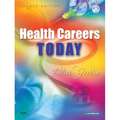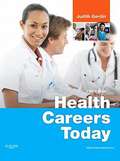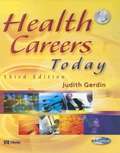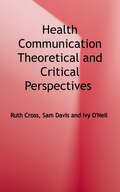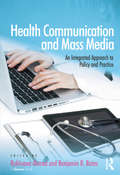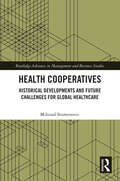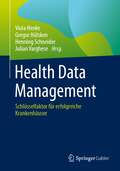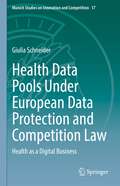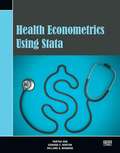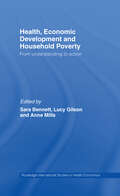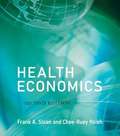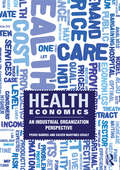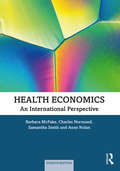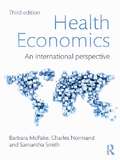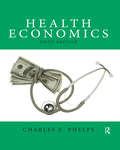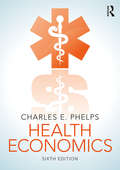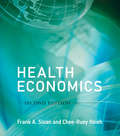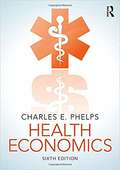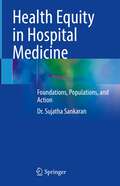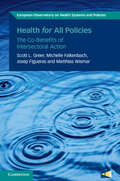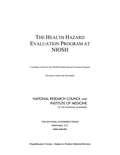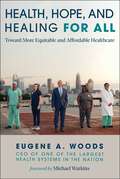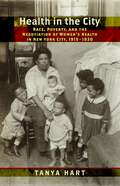- Table View
- List View
Health Careers Today
by Judith GerdinCovering more than 45 health careers, this book offers a practical overview to help students make an informed decision in choosing a profession. Not only does it discuss the roles and responsibilities of various occupations, it provides a solid foundation in the skills needed for all health careers. Clear explanations of anatomy and physiology provide essential knowledge of health related to the human body, and show how this applies to different careers. Content in the book now adheres to and reflects National Health Care Skills Standards. A clear writing style makes it easy for students to explore health career options. Health career discussions include the requirements and roles and responsibilities of each. Full-color drawings and photographs illustrate concepts, techniques, and equipment. Summaries of essential points introduce new concepts and help with exam preparation. Anatomy and Physiology unit covers all of the body systems, and applies A&P to practice. Skill Activities provide the opportunity to obtain hands-on experience. Learning Objectives at the beginning of each chapter help readers focus on key information. Key Terms with definitions are listed at the beginning of each chapter. Core concepts are reinforced with more than 70 content boxes, skill boxes, review questions, and critical thinking questions. A comprehensive glossary includes all key terms and definitions for quick reference. The companion CD-ROM has been completely revised, now including over 20 all-new skills videos, animations, chapter-specific quizzes, and an audio glossary. NEW Culture and Health Care chapter provides information on cultural and religious diversity as required by the National Health Care Skills Standards (NHCSS), including strategies that various cultures use to solve health-related problems, clients and patients who use English as a second language, and the awareness of religious diversity as it relates to client care. NEW Standards and Accountabilities section appears at the end of appropriate chapters, with the specific number and name of each national standard covered, along with its page number, so that correlations can be found quickly and easily. Revised Interpersonal Dynamics and Communication chapter now includes information on team-building, goal-setting, evaluation, and traits of leaders and team members. NEW chapter summaries review and identify vital content covered in each chapter. Seven new skills have been added, offering additional hands-on experience.
Health Careers Today
by Judith GerdinDescribing more than 45 health careers, Health Careers Today, 5th Edition offers a practical overview to help you make an informed decision in choosing a profession. Not only does it discuss the roles and responsibilities of various occupations, it provides a solid foundation in the skills needed for all health careers. Clear explanations of anatomy and physiology provide essential knowledge of health related to the human body, and show how this applies to different careers. A companion Evolve website includes skills videos, animations, quizzes, and flashcards. Written by experienced educator Judith Gerdin, this book reflects National Health Care Skills Standards. A clear, easy-to-read approach makes it easy to explore health career options. Over 45 health careers are discussed, including the requirements and roles and responsibilities of each. Full-color drawings and photographs illustrate concepts, techniques, and equipment. The National Health Care Skills Standards are incorporated, and the book's organization closely follows the standards. An Anatomy and Physiology unit covers all of the body systems, and applies A&P to various career settings. Skill Activities provide the opportunity to obtain hands-on experience. Learning Objectives at the beginning of each chapter focus on key information. Key Terms with definitions are listed at the beginning of each chapter. Core concepts are reinforced with more than 70 content boxes, skill boxes, review questions, and critical thinking questions. National Standard sections summarize the specific number and name of each national standard covered in that chapter, along with page references. Chapter summaries make it easy to review and identify key content. A comprehensive glossary includes all key terms and definitions for quick reference. Student resources on a companion Evolve website include fill-in-the-blank and drag-and-drop quizzes, flashcards, anatomy and physiology animations, skill videos, an audio glossary, and web links. A workbook corresponds to the chapters in the textbook, and features learning activities such as vocabulary practice exercises, medical abbreviation practice exercises, coloring/labeling activities, concept application exercises, laboratory exercises, critical thinking exercises, and Internet activities. Sold separately. Updated and expanded content covers the electronic medical record, HIPAA, examples of career ladders in various health professions, superbugs and MRSA, cultural diversity, autism, BMI and its relationship to obesity, infection control, basic methods of cleaning and sterilizing instruments, HOSA guidelines, and all NHCSS (National Health Care Skills Standards) required information. Bios and photographs feature working professionals in many health careers, adding personal stories that you can relate to. Brain bytes reinforce concepts and keep you engaged in the material. New photographs show workers in various health care settings. References to websites connect you to online resources and research. Full-page forms are located in the appendix, with printable versions available on the companion Evolve website for use in assignments.
Health Careers Today (3rd Edition)
by Judith GerdinThis valuable guide provides an introduction to the basic health care environment and a preview of various popular health careers designed to help students make informed choices based on their interest and their commitment to the educational and professional responsibilities of each health career. It gives students a realistic glimpse of various health careers available today, outlining the roles and responsibilities, levels of education and credentialing, daily functions, and key disorders and assessment tools that are involved.
Health City Cayman Islands
by Tarun Khanna Budhaditya GuptaNarayana Health (NH) had been successfully delivering affordable high quality tertiary care to the masses in India through its chain of hospitals for over a decade. To encourage the adoption of the NH affordable care delivery model worldwide, Dr. Shetty, Chairman of NH, was keen to establish a hospital in the western hemisphere and believed that it was important to demonstrate the model to the US. Thus when the Cayman Islands Government was interested in developing the island as a medical tourism hub during 2008-09, Dr. Shetty agreed to develop the Health City Cayman Islands (HCCI), a 2,000 bed conglomeration of multiple super-specialty hospitals within a single campus located on the Grand Cayman Island. The first phase of HCCI, a 104 bed hospital focused on cardiac care and orthopedics, was developed jointly by NH and Ascension, the largest non-profit hospital system in US. The hospital was inaugurated in February, 2014 but there were open questions related to pricing of the procedures and the related target patient segment and volumes. Also, HCCI senior management realized the need to adapt the NH model developed in and for India to fit the new environment at Cayman and was open to experimentation in coming months.
Health Communication: Theoretical and Critical Perspectives
by Ruth Cross Sam Davis Ivy O'NeilHealth communication is key to promoting good population and individual health outcomes. As the field has developed, there is a growing need for a critical appraisal of the ideologies and theories underpinning health communication in order to ensure effective practice. This book clearly situates health communication within its social context. It provides a critical overview of three key disciplinary areas - education, psychology and communication. Drawing on international examples throughout, the book challenges the underlying assumptions that drive the design and delivery of health promotion interventions. The authors argue that health communication is inherently political and pay close attention to issues of power, ethics and inequality throughout the text. This book will be valuable for those students at all levels who require a critical perspective, as well as practitioners in health communication and health promotion. With reference to detailed examples and annotated suggestions for further reading, the book is an accessible resource for analysing contemporary health communication.
Health Communication and Mass Media: An Integrated Approach to Policy and Practice
by Rukhsana Ahmed Benjamin R. BatesHealth Communication and Mass Media is a much-needed resource for those with a professional or academic interest in the field of health communication. The chapters engage and expand upon significant theories informing efforts at mediated health communication and demonstrate the practical utility of these theories in on-going or completed projects. They consider how to balance the ethical and efficacy demands of mediated health communication efforts, and discuss both traditional media and communication systems and new web-based and mobile media. The book's treatment is broad, reflecting the topical and methodological diversity in the field. It offers an integrated approach to communication theory and application. Readers will be able to appreciate the ways that theory shapes health communication applications and how those applications inform the further construction of theory. They will find practical examples of mediated health communication that can serve as models for their own efforts. While the book serves as an introduction to mediated health communication for students, professionals, and practitioners with limited experience, researchers and advanced practitioners will also appreciate the exemplars and theoretical insights offered by the chapter authors. This book will be of interest to anyone involved in health communication programs or more generally with communication and allied studies, as well as to those in the health professions and their related fields.
Health Cooperatives: Historical Developments and Future Challenges for Global Healthcare (Routledge Advances in Management and Business Studies)
by Milorad StamenovicIn the era of complex healthcare challenges, the question arises: Can health cooperatives be the catalysts for transformation in the healthcare system? This research monograph delves into this thought-provoking query, exploring the potential of health cooperatives as influential entities in the future of healthcare. Despite advancements, healthcare systems still need help with sustainability, equality, costly therapies and various other segments. This monograph aims to dissect the notion of "Healthy lives and well-being for everyone," protracted by policymakers and proponents of the existing healthcare setup. Researchers, cooperative professionals, healthcare practitioners, decision-makers, patients, policy developers, librarians and booksellers will find this book relevant and interesting to read. The captivating narrative is supported by analysing 20 countries across five continents, explaining their historical and modern notion of the context and health cooperatives' development. It also sheds light on the significance of modern cooperatives in the current healthcare landscape. In addition, the monograph offers insights into multiple case studies of health-oriented cooperatives showing their diversity and flexibility in operations. This research monograph paves the way for envisioning a future where health cooperatives have the potential to play an important role in addressing various challenges affecting positive societal changes.
Health Data Management: Schlüsselfaktor für erfolgreiche Krankenhäuser
by Viola Henke Gregor Hülsken Henning Schneider Julian VargheseNeben der Einführung und Umsetzung einer Digitalstrategie spielt die ganzheitliche Verwaltung und Organisation von Gesundheitsdaten eine essenzielle Rolle für den Erfolg bei der digitalen Transformation in Krankenhäusern – kurz: ein professionelles Health Data Management (HDM).Dieses Buch widmet sich dieser Herausforderung, indem es in zahlreichen Expertenbeiträgen die dafür notwendigen Handlungsfelder aufzeigt – sie reichen von der Informationsstruktur und -architektur über die Datenerfassung und den interoperablen Datenaustausch bis hin zur Datenanalyse mit Künstlicher Intelligenz, Datenschutz und IT-Sicherheit. Anhand von Praxisbeispielen werden Bedeutung, Chancen, Herausforderungen und Lösungsansätze des Health Data Managements erläutert und konkrete Umsetzungsempfehlungen für den Wissenstransfer in den Klinikalltag gegeben.Die technischen Faktoren sollten bei der Planung und Umsetzung des HDM idealerweise durch „weiche“ Faktoren ergänzt werden, wie Unternehmenskultur, Führungsqualität und Mitarbeitermotivation, damit die Interaktion zwischen Mensch, Technologie, Prozessen und Kultur bei der digitalen Transformation im Krankenhaus gelingen kann. Nur so können Arbeitsabläufe verbessert, die Patientenversorgung optimiert, Prozesse vereinfacht, Diagnosen zielgenauer, Pflegekräfte und Ärzte entlastet und das Krankenhaus als Ganzes effizienter und wirtschaftlicher werden. Ein Blick in die Gesundheitssysteme anderer Länder und ihre Datenstrategien rundet dieses Buch ab.Health Data Management ist nicht nur ein technisches, sondern vielmehr ein gesellschaftliches Projekt mit dem Potenzial, das Gesundheitswesen grundlegend zu verändern und die Versorgung der Patienten auf ein neues und nachhaltiges Level zu heben.
Health Data Pools Under European Data Protection and Competition Law: Health as a Digital Business (Munich Studies on Innovation and Competition #17)
by Giulia SchneiderThis book explores the emerging economic reality of health data pools from the perspective of European Union policy and law. The contractual sharing of health data for research purposes is giving rise to a free movement of research data, which is strongly encouraged at European policy level within the Digital Single Market Strategy. However, it has also a strong impact on data subjects' fundamental right to data protection and smaller businesses and research entities ability to carry out research and compete in innovation markets. Accordingly the work questions under which conditions health data sharing is lawful under European data protection and competition law. For these purposes, the work addresses the following sub-questions: i) which is the emerging innovation paradigm in digital health research?; ii) how are health data pools addressed at European policy level?; iii) do European data protection and competition law promote health data-driven innovation objectives, and how?; iv) which are the limits posed by the two frameworks to the free pooling of health data? The underlying assumption of the work is that both branches of European Union law are key regulatory tools for the creation of a common European health data space as envisaged in the Commissions 2020 European strategy for data. It thus demonstrates that both European data protection law, as defined under the General Data Protection Regulation, and European competition law and policy set research enabling regimes regarding health data, provided specific normative conditions are met. From a further perspective, both regulatory frameworks place external limits to the freedom to share (or not share) research valuable data.
Health Development Corp.
by Richard S. RubackHealth Development Corp. (HDC) owns and operates health clubs in the Greater Boston area. HDC engaged a local investment banker to explore a sale of the company. The most likely buyer views HDC's prior purchase of real estate as a negative. HDC's management is convinced the purchase enhanced value, and a discounted cash flow analysis confirms that it was a substantially positive net present value decision. Nevertheless, the real estate reduces the valuation according to the approach used by the potential buyer. The challenge is to structure a transaction that allows HDC to realize its full value.
Health Econometrics Using Stata
by Partha Deb Edward Norton Willard ManningHealth Econometrics Using Stataby Partha Deb, Edward C. Norton, and Willard G. Manning provides an excellent overview of the methods used to analyze data on healthcare expenditure and use. Aimed at researchers, graduate students, and practitioners, this book introduces readers to widely used methods, shows them how to perform these methods in Stata, and illustrates how to interpret the results. Each method is discussed in the context of an example using an extract from the Medical Expenditure Panel Survey. After the overview chapters, the book provides excellent introductions to a series of topics aimed specifically at those analyzing healthcare expenditure and use data. The basic topics of linear regression, the generalized linear model, and log and Box-Cox models are covered with a tight focus on the problems presented by these data. Using this foundation, the authors cover the more advanced topics of models for continuous outcome with mass points, count models, and models for heterogeneous effects. Finally, they discuss endogeneity and how to address inference questions using data from complex surveys. The authors use their formidable experience to guide readers toward useful methods and away from less recommended ones. Their discussion of "health econometric myths" and the chapter presenting a framework for approaching health econometric estimation problems are especially useful for this aspect. , count models, and models for heterogeneous effects. Finally, they discuss endogeneity and how to address inference questions using data from complex surveys. The authors use their formidable experience to guide readers toward useful methods and away from less recommended ones. Their discussion of "health econometric myths" and the chapter presenting a framework for approaching health econometric estimation problems are especially useful for this aspect.
Health, Economic Development and Household Poverty: From Understanding to Action (Routledge International Studies in Health Economics #Vol. 5)
by Sara Bennett Lucy Gilson Anne MillsAccessible and edited by authors based at a top institution, this book provides readers with an excellent summary in an easy-to-read style of this burgeoning field of research. In this volume Bennett, Gilson and Mills have gathered together essays written by academics and experts in the fields of health policy and economic development, each underscoring the need for political commitment to meet the needs of the poor and the development of strategies to build this commitment, covering: evidence regarding the links between health, economic development and household poverty evidence on the extent to which health care systems address the needs of the poor and the near poor innovative measures to make health care interventions widely available to the poor. Current and topical, this book is of great relevance to policy makers and practitioners in the field of international health and development and researchers engaged with global health and poverty as well as being ideal reading for students of international health and development.
Health Economics
by Chee-Ruey Hsieh Frank A. SloanThis book introduces students to the growing research field of health economics. Rather than offer details about health systems without providing a theoretical context, Health Economics combines economic concepts with empirical evidence to enhance readers' economic understanding of how health care institutions and markets function. The theoretical and empirical approaches draw heavily on the general field of applied microeconomics, but the text moves from the individual and firm level to the market level to a macroeconomic view of the role of health and health care within the economy as a whole. The book takes a global perspective, with description and analysis of institutional features of health sectors in countries around the world. This second edition has been updated to include material on the U.S. Patient Protection and Affordable Care Act, material on the expansion of health insurance in Massachusetts, and an evaluation of Oregon's Medicaid expansion via lottery. The discussion of health care and health insurance in China has been substantially revised to reflect widespread changes there. Tables and figures have been updated with newly available data. Also new to this edition is a discussion of the health economics literature published between 2010 and 2015. The text includes readings, extensive references, review and discussion questions, and exercises. A student solutions manual offers solutions to selected exercises. Downloadable supplementary material is available for instructors.
Health Economics: An Industrial Organization Perspective
by Xavier Martinez-Giralt Pedro BarrosResearch in Health Economics has developed into a separate discipline for the last 25 years. All this intense research activity, has translated in the inclusion of courses of health economics, mostly at graduate level. However, the Industrial Organization aspects of the health care market do not occupy a central place in those courses. We propose a textbook of health economics whose distinguishing feature is the analysis of the health care market from an Industrial Organization perspective. This textbook will provide teachers and students with a reference to study the market structure aspects of the health care sector. The book is structured in three parts. The first part will present the basic principles of economics. It will bring all readers to the required level of knowledge to follow subsequent parts. Part II will review the main concepts of health economics. The third part will contain the core of the book. It will present the industrial organization analysis of the health care market, based on our own research.
Health Economics: An International Perspective
by Barbara McPake Charles Normand Samantha Smith Anne NolanHealth Economics: An International Perspective is the only textbook to provide a truly international, comparative treatment of health economics. Offering an analysis of health systems across borders, the fourth edition of this key text has been updated and revised to take account of changes in a host of countries. This edition features an expanded introduction, providing better grounding for many of the examples that come in subsequent chapters and making it easier for non-health care experts to see the links between the theory, the examples and the health care system components. It also boasts a restructured format, dividing the book into two broad sections: the first focuses on ideas and principles, along with evidence on their applications in the health sector, whereas the second focuses on introducing core tools and techniques used in applied health economics research. Further updates to this edition include: two new chapters on applied econometrics; a new chapter on equity, focusing on equity in access to health care, paying particular attention to how access and need for health care are defined and measured in applied research; a new chapter on emerging issues for health systems that are emanating from a series of global transitions both within (e.g. demographic change, epidemiological change, the global resolution on universal health coverage) and without the health sector (e.g. economic transitions). Throughout the text, examples and illustrations are taken from a wide range of settings and world regions, providing a unique overview of the performance of different health systems.
Health Economics: An International Perspective
by Barbara Mcpake Samantha Smith Charles NormandThis third edition of Barbara McPake and Charles Normand's textbook confirms it as providing the only properly international treatment of health economics on the market. A key tenet of the book is its analysis of comparative health systems across borders, and the text has been updated and revised to take account of changes in a host of countries. Barack Obama's reforms in the United States are considered alongside the provision of healthcare in China, providing a unique overview of these different approaches. The introduction of performance related payment in various forms is appraised, with the experience of developing countries such as Cambodia, Rwanda and Uganda important in this regard. An overview of the range of mathematical techniques available to perform economic evaluation in healthcare is also introduced, although the text avoids becoming too technical. In all, the text builds on the success of the first edition and provides the perfect introduction to the fast changing world of health economics.
Health Economics
by Charles E. PhelpsHealth Economics combines current economic theory, recent research, and health policy problems into a comprehensive overview of the field. This thorough update of a classic and widely used text follows author Charles E. Phelps' thirteen years of service as Provost of the University of Rochester. Accessible and intuitive, early chapters use recent empirical studies to develop essential methodological foundations. Later chapters build on these core concepts to focus on key policy areas, such as the structure and effects of Medicare reform, insurance plans, and new technologies in the health care community. This edition contains revised and updated data tables and contains information throughout the text on the latest changes that were made to the Patient Protection and Affordable Care Act (PPACA).
Health Economics
by Charles E. PhelpsCan we really use economic thinking to understand our health care system? Health Economics, now in its sixth edition, not only shows how this is done, but also provides the tools to analyze the economic behavior of patients and providers in health care markets. Health Economics combines current economic theory, recent research, and up-to-date empirical studies into a comprehensive overview of the field. Key changes to this edition include: additional discussion of the consequences of the Patient Protection and Affordable Care Act (PPACA), in light of current political changes; an extensive discussion of quality measures; more discussion of preventive services; a new section on drug markets and regulation; discussion of Accountable Care Organizations (ACOs); new references, problem sets, and an updated companion website with lecture slides. Designed for use in upper-division undergraduate economics studies, the book is suitable for students and lecturers in health economics, microeconomics, public health policy and practice, and health and society. It is also accessible to professional students in programs such as public policy, public health, business, and law.
Health Economics, second edition: Kenneth Arrow And The Changing Economics Of Health Care (The\mit Press Ser. #5)
by Frank A. Sloan Chee-Ruey HsiehThe new edition of a textbook that combines economic concepts with empirical evidence, updated with material on the Affordable Care Act and other developments.This book introduces students to the growing research field of health economics. Rather than offer details about health systems without providing a theoretical context, Health Economics combines economic concepts with empirical evidence to enhance readers' economic understanding of how health care institutions and markets function. The theoretical and empirical approaches draw heavily on the general field of applied microeconomics, but the text moves from the individual and firm level to the market level to a macroeconomic view of the role of health and health care within the economy as a whole. The book takes a global perspective, with description and analysis of institutional features of health sectors in countries around the world. This second edition has been updated to include material on the U.S. Patient Protection and Affordable Care Act, material on the expansion of health insurance in Massachusetts, and an evaluation of Oregon's Medicaid expansion via lottery. The discussion of health care and health insurance in China has been substantially revised to reflect widespread changes there. Tables and figures have been updated with newly available data. Also new to this edition is a discussion of the health economics literature published between 2010 and 2015. The text includes readings, extensive references, review and discussion questions, and exercises. A student solutions manual offers solutions to selected exercises. Downloadable supplementary material is available for instructors.
Health Economics (Sixth Edition)
by Charles E. Phelps<p>Can we really use economic thinking to understand our health care system? Health Economics, now in its sixth edition, not only shows how this is done, but also provides the tools to analyze the economic behavior of patients and providers in health care markets. <p>Health Economics combines current economic theory, recent research, and up-to-date empirical studies into a comprehensive overview of the field. Key changes to this edition include: <p> <li>additional discussion of the consequences of the Patient Protection and Affordable Care Act (PPACA), in light of current political changes; <li>an extensive discussion of quality measures; <li>more discussion of preventive services; <li>a new section on drug markets and regulation; <li>discussion of Accountable Care Organizations (ACOs); <li>new references, problem sets, and an updated companion website with lecture slides. <p> <p>Designed for use in upper-division undergraduate economics studies, the book is suitable for students and lecturers in health economics, microeconomics, public health policy and practice, and health and society. It is also accessible to professional students in programs such as public policy, public health, business, and law.</p>
Health Equity in Hospital Medicine: Foundations, Populations, and Action
by Sujatha SankaranHospital-based physicians are privy to some of the most meaningful moments of people’s lives, including life-changing diagnoses, pivotal medical procedures, complex medical decisions, and critical end-of-life decisions. Yet, hospitalists have no framework for how to incorporate the varied social factors that impact care such as race, gender identity, cultural background, immigration status, sexual orientation, primary language, housing status, and poverty into clinical decision-making. As hospital physicians, we may use interpreters for our limited English proficiency patients, or try to incorporate questions about cultural practices into our admission histories, or even ask our patients about the ways in which they feel racism has affected their care, but these practices are inconsistently applied and lack a systematic framework for ensuring that the hospital care we provide is truly equitable. In my own practice as a hospital-based physician, I can recall scores of hospitalized patients where we tried hard to provide equitable care, but fell short. I remember the Spanish-speaking patient with multiple comorbidities who received neurosurgery and was on the road to recovery on an acute care unit, when on day three, he complained of vague abdominal discomfort and ended up dying of a perforated bowel. No interpreter was used by the team to fully delve into the details of the pain he was experiencing. I remember the young Black patient with terminal malignancy who had multiple repeated conversations with physicians recommending hospice care but refused until he saw a physician who was able to explain hospice within the context of racism that has historically defined clinical care for Black people, and was able to present hospice not as a way to hasten death but rather as a way to live the remainder of his days in comfort. I remember the elderly Pakistani female patient whose demanding son antagonized staff and clinicians alike until he was banned from visiting because of his aggressiveness with staff and whose inability to visit his mother caused her extreme distress as she felt that she had lost the unique voice that only her oldest son could provide. Imagine if the hospital physicians in these cases had a resource to help them provide care that is culturally humble, that goes beyond just speaking in the patient’s first language but that also includes active listening and truly takes into consideration the life experiences and culture that have made this patient who they are. This is what this book will provide for hospital medicine physicians, a framework to help hospital physicians deeply incorporate social factors into the care they provide.
Health for All Policies: The Co-Benefits of Intersectoral Action (European Observatory on Health Systems and Policies)
by Scott L. Greer Michelle Falkenbach Josep Figueras Matthias WismarFactors outside of healthcare services determine our health and this involves many different sectors. Health for All Policies changes the argument about inter-sectoral action, from one focusing on health and the health sector to one based on co-benefits – a 'Health for All Policies' approach. It uses the Sustainable Development Goals as the framework for identifying goals across sectors and summarizes evidence along two causal axes. One is the impact of improved health status on other SDGs, e.g. better educational and employment results. The other is the impact of health systems and policies on other sectors. The 'Health for All Policies' approach advocated in this book is thus a call to improve health to achieve goals beyond health and for the health sector itself to do better in understanding and directing its impact on the world beyond the healthcare it provides. This title is also available as Open Access on Cambridge Core.
The Health Hazard Evaluation Program at NIOSH: Reviews of Research Programs of the National Institute for Occupational Safety and Health
by National Research Council Institute of Medicine of the National AcademiesIt is the unique mission of the Health Hazard Evaluation Program within the National Institute for Occupational Safety and Health (NIOSH) to respond to requests to investigate potential occupational health hazards. In contrast to other NIOSH programs, the Health Hazard Evaluation Program is not primarily a research program. Rather, it investigates and provides advice to workplaces in response to requests from employers, employees and their representatives, and federal agencies. The National Research Council was charged with evaluating the NIOSH Health Hazard Evaluation Program and determining whether program activities resulted in improvements in workplace practices and decreases in hazardous exposures that cause occupational illnesses. The program was found to play a key role in addressing existing widespread or emerging occupational health issues. This book makes several recommendations that could improve a very strong program including more systematic use of surveillance data to facilitate priority setting, and greater interaction with a broader array of workers, industries, and other government agencies.
Health, Hope, and Healing for All: Toward More Equitable and Affordable Healthcare
by Eugene A. WoodsOne of America&’s top healthcare leaders offers a prescription to fix an ailing and inequitable healthcare system In Health, Hope, and Healing for All, Eugene A. Woods, CEO of Advocate Health, one of the largest non-profit health systems in the nation, provides a riveting behind-the-scenes look at healthcare in the United States. By sharing his insights from three decades in healthcare administration, as well as his personal journey, readers gain a deeper understanding of the challenges facing healthcare systems and the impact on all of us. Woods sheds light on the inequities our communities face, especially in the context of the COVID-19 pandemic, and presents actionable prescriptions to create a more equitable, just and accessible healthcare system. He tackles tough questions around the affordability of healthcare, rising drug prices, alarming clinical shortages and more. As a Black healthcare CEO, Woods shares his personal experiences with injustice and charts a path towards meaningful change. His optimistic outlook and passion for transformation and innovation inspire readers to believe in the power of unity and resilience in the face of adversity.Health, Hope, and Healing for All is a must-read for those working in healthcare, policymakers, and individuals seeking hope and answers in an uncertain healthcare landscape. Supported by Woods' expertise and credibility, the book presents real solutions to the current crisis and highlights the urgent need to ensure accessible, affordable and compassionate healthcare for every American.
Health in the City: Race, Poverty, and the Negotiation of Women’s Health in New York City, 1915–1930 (Culture, Labor, History #9)
by Tanya HartShortly after the dawn of the twentieth century, the New York City Department of Health decided to address what it perceived as the racial nature of health. It delivered heavily racialized care in different neighborhoods throughout the city: syphillis treatment among African Americans, tuberculosis for Italian Americans, and so on. It was a challenging and ambitious program, dangerous for the providers, and troublingly reductive for the patients. Nevertheless, poor and working-class African American, British West Indian, and Southern Italian women all received some of the nation's best health care during this period. Health in the City challenges traditional ideas of early twentieth-century urban black health care by showing a program that was simultaneously racialized and cutting-edge. It reveals that even the most well-meaning public health programs may inadvertently reinforce perceptions of inferiority that they were created to fix.
